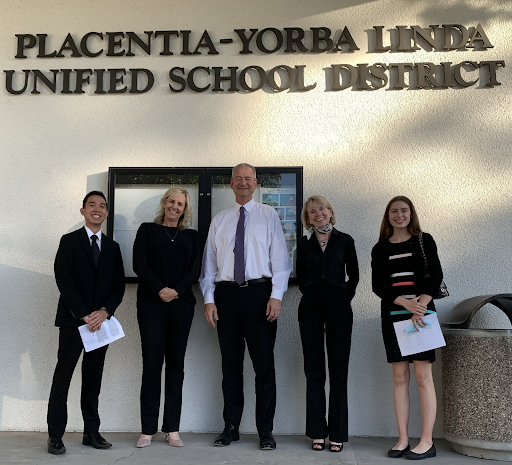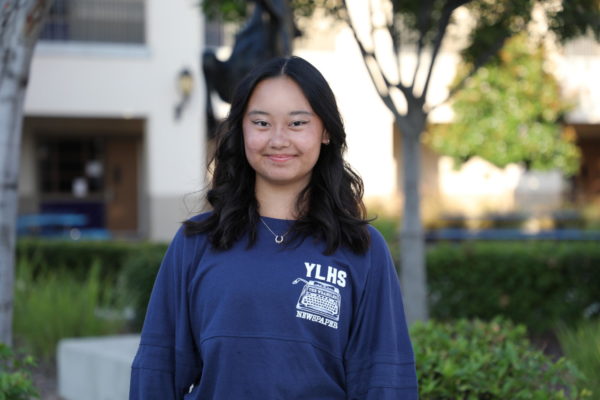Yorba Linda High School Students Influencing District Policy

Dr. James Elsasser, Dr. Linda Adamson, and Mrs. Gina Aguilar with Jered Baloloy (12) and Madison Ems (10) at the PYLUSD District Office.
May 3, 2022
Placentia-Yorba Linda Unified School District (PYLUSD) Students are extremely fortunate to be the most integral part of their district. They are supported from the first day they walk into their Transitional Kindergarten teacher’s welcoming homeroom to the day they graduate from their high school among their classmates and lifelong friends made only as a result of being a part of PYLUSD. However, they are also fostered by a different kind of administration, actively involved in creating and maintaining policy.
Dr. James Elsasser serves as the Superintendent of Schools leading this operation. Joining him in the crusade to encourage the quality education of students is the Board of Education. The Board consists of five passionate, accomplished people who are very dedicated to their community: President Carrie Buck, Vice President Marilyn Anderson, Clerk Leandra Blades, Trustee Shawn Youngblood, and Trustee Karin Freeman. Together with parents and student representatives, a productive meritocracy is effectively achieved.
Given that student-feedback is essential in accurately gauging school life, Jered Baloloy (12), Madison Ems (10), and I decided to get involved in providing input to the District. We visited Dr. Elsasser, Assistant Superintendent Dr. Linda Adamson, and High School Education Director Mrs. Gina Aguilar to discuss a couple topics from the student perspective: hybrid learning, special program funding, and lunches.
First off, we inquired about the transition process from online learning to hybrid, and hybrid learning to fully in-person learning. We have heard students raise concerns about “bridging the gap,” and asked how the District was working to ease the stress placed on students and teachers. According to Dr. Adamson, District Student Diagnostic Test iReady scores were lower than average, and they were aware of the educational disruption in schools as a result of the movement of schools online via zoom. However, she explained that at last year’s April Board Meeting (when there was a hybrid option), the scores doubled from 2020. We also called attention to the physical, mental, and emotional health of students in regards to teachers getting accustomed to teaching in-person, and making up for missed curriculum. Dr. Elsasser responded that more intervention teachers were hired for “one-on-one help” for students, especially in middle schools. PYLUSD reportedly received a $1.4 million grant to “help students at risk of not completing A-G college requirements.” This funding was allocated to ensure students received extra support, usually via counseling. A focus on grading equity was placed with an emphasis on secondary students. A large victory for students was the District’s intentional actions ensuring that there would be a smaller teacher to student ratio. Dr. Elsasser mentioned that it was a “big investment,” for which we are very grateful. Important achievements to note include the fact that PYLUSD was one of the first districts in the country to bring students back to (hybrid) school after COVID-19 precautions and restrictions weakened, as well as the option for students to attend free summer school to make up for lost credits. They encouraged computer literacy for both students and teachers, and provided chromebooks for those who needed technology at home. Professional Learning Communities (PLCs) and Early Bird Teacher Trainings were also an option. Finally, we discussed the helpfulness of free 24-hour online tutoring service PAPER.co.
Special Program Funding:
Next, we talked about the condition of school arts and co-curricular programs. Jered observed that overall band participation numbers dropped in 2021-2022 from those from 2018-2019. He mentioned that fewer students often leads to less funding, resulting in more fees for the remaining band students. Dr. Elsasser and Mrs. Aguilar were unaware of this issue, leading them to respond to us that they would be looking into it in the near future. This is an excellent example of the benefits of students retrieving first-hand information to provide to management that can alleviate problems.
Another issue that affects almost all students is inefficient lunches. We asked Dr. Elsasser about the quality of school lunches and if the District had attempted to make school-provided food palatable to the student body. He responded that there had been tastings conducted with PYLUSD students sampling meals from chefs, and that the matter was being handled. Dr. Elsasser, Dr. Adamson, and Mrs. Aguilar attributed unreasonably long lunch lines and insufficient time to eat, study, relax, and attend student-run club meetings to the COVID-19 era policy of “free” school lunches to everyone. More interest in claiming food has led to longer lines, as well as a shortage in food services staff. Regarding the scarcity of lunch operators, they stated that new hiring programs were implemented, and that PYLUSD is working on solutions to combat it.
Fellow YLHS students have responded positively to our discussion with Superintendent Elsasser, In the words of Isabella Smith (11), “I appreciate that somebody is stepping up to give more attention to the lunch lines for school. It takes a while to receive a meal, and lunch is often cut very short. I think more rules should be put in place—especially for people who cut in line.”
It is paramount that students get involved in the creation of policies that concern them and future generations of learners. We thank PYLUSD for the bountiful opportunities provided to us, including the opportunity to meet with District Administration.


































